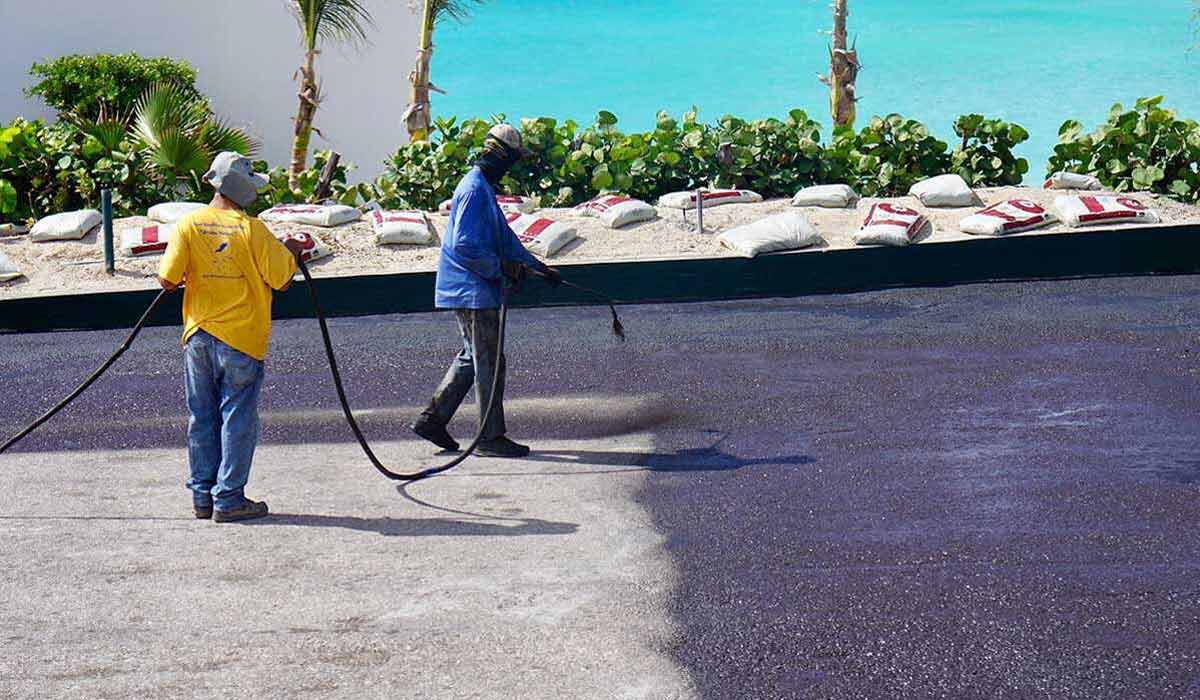There’s something quiet and deceiving about humidity. It creeps in. Rain and heat announce themselves pretty blatantly, but humidity is more like a weight in the air.
Humidity can mess with your schedule, delay your drying times, and throw a wrench into what should be a routine job. But here’s the thing: it doesn’t have to. If you understand the relationship between asphalt and humidity, you can work with it, not against it.
Let’s break down what’s really happening when moisture lingers in the air, and how you can keep your sealcoating jobs on track even in less-than-ideal conditions.
Table of Contents
Does Humidity Affect Asphalt Sealing? Yes, And Here’s How

First, let’s answer the basic question: does humidity affect asphalt sealing?
Absolutely. In fact, humidity is one of the most important environmental factors to consider, right up there with temperature and sunlight.
When you apply sealer to a driveway or parking lot, you’re relying on evaporation. The water in the sealcoat mix needs to evaporate for the product to cure properly. High humidity slows that process down. If it’s too slow, you get:
- Longer drying times
- Soft or tacky surfaces
- Poor bonding to the pavement
- Dust and debris embedding in the uncured sealant
In short, your work becomes more vulnerable to footprints, tire marks, even pop-up rainstorms that wouldn’t have been a problem under drier conditions.
Why Humidity Matters More Than You Think
Humidity is tricky because it’s not always visible. You can look at the thermometer and know it’s 85 degrees, but 85 on a dry day is not the same as 85 when the air’s sitting heavy with moisture.
In humid weather, the water vapor in the air slows down the evaporation of the water in your sealcoat. You might finish your job on time, but the surface takes longer to set. That means your client’s lot or driveway might still be vulnerable hours after you’ve left.
And remember, drying isn’t the same as curing. That’s the chemical process that gives the sealcoat its strength and resilience. If humidity hangs around too long, the asphalt never quite hardens the way it’s supposed to.
Sealing Asphalt in Humid Weather: What You Need to Know
You can’t always avoid humid days, especially in summer. But you can adjust your approach. Here’s how to work smart when the air’s heavy:
-1.jpg?width=720&height=405&name=Blog%20Images%20(36)-1.jpg)
1. Check the dew point, not just the temperature
Most contractors look at the temperature forecast, but that’s only part of the equation. The dew point tells you how close the air is to being saturated. A higher dew point means slower evaporation and longer drying times.
As a rule of thumb, if the dew point is over 70°F, proceed with caution.
2. Start earlier in the day
In humid conditions, you’ve got a limited window where things work in your favor. Mornings tend to be cooler and drier than afternoons, especially before the sun heats everything up. Plan your sealing work early to give the surface maximum time to dry before nightfall, when temperatures and evaporation rates drop again.
3. Watch your film thickness
Thicker isn’t always better, especially when you’re sealing asphalt in humid weather. A thick application takes longer to dry and can trap moisture underneath, leading to soft spots and poor adhesion. Apply thin, even coats and allow plenty of time between them.
If you’re not sure what “plenty of time” means, check out this Application Temperature Cheat Sheet. It breaks down ideal conditions for sealing asphalt based on temperature and humidity; bookmark it, print it, live by it.
4. Use the right sealer for the conditions
Not all sealers perform the same way in humid weather. Some are formulated to handle moisture better than others. If you frequently work in a high-humidity area, consider switching to a sealer with faster drying technology or one designed for cooler, wetter climates.
The Hidden Risks of Ignoring Humidity
Maybe you’ve sealed a driveway on a humid day and nothing went wrong. Great. But that doesn’t mean the next one won’t be a problem. Inconsistent curing can lead to early wear, discoloration, and customer complaints weeks or months down the line.
Humidity is subtle and that’s what makes it dangerous. You can’t always see it coming, but it can ruin a job all the same.
You’re not just protecting your client’s pavement; you’re protecting your reputation. Learning how to navigate high humidity is one of those unspoken skills that separates amateurs from pros.
Humidity and Nighttime Curing: A Double Whammy
Here’s another thing to consider: what happens after you leave? Even if you applied the sealcoat under good conditions, humid air lingering into the evening can disrupt curing overnight.
Nighttime humidity tends to rise, and without the help of sunlight to encourage evaporation, your sealer may stay tacky or uneven. That’s when you get premature damage like footprints, streaks, and grit from the wind.
So, if you’re sealing later in the day on a humid afternoon, factor in the overnight environment. A longer cure time might mean recommending the customer wait until mid-morning the next day before driving on the surface.
How to Communicate with Your Clients
Clients might not know (or care) about dew points or curing times. That’s why they’re hiring you. It’s your job to manage expectations and explain why a job might need to be rescheduled, or why they can’t walk or drive on it as soon as they’d like.
Use language that’s simple but authoritative:
“Because of the humidity today, it’ll take a little longer for the sealant to fully cure. We recommend staying off it until tomorrow afternoon to make sure it sets properly.”
Being proactive builds trust. It shows that you’re thinking beyond the initial asphalt laying; you’re managing conditions, outcomes, and long-term quality.
Humidity Is Part of the Job, So Plan for It
You can’t change the weather, but you can prepare for it. Humidity is one of those forces that can shape the outcome of a job just as much as technique or tools.
By paying attention to environmental cues, timing your work right, and making adjustments when needed, you stay one step ahead of the elements. And that’s what professionalism really comes down to, doing the job right, even when the air’s thick and the clock’s ticking.
-2.jpg?width=720&height=405&name=Blog%20Images%20(9)-2.jpg)




.jpg)
